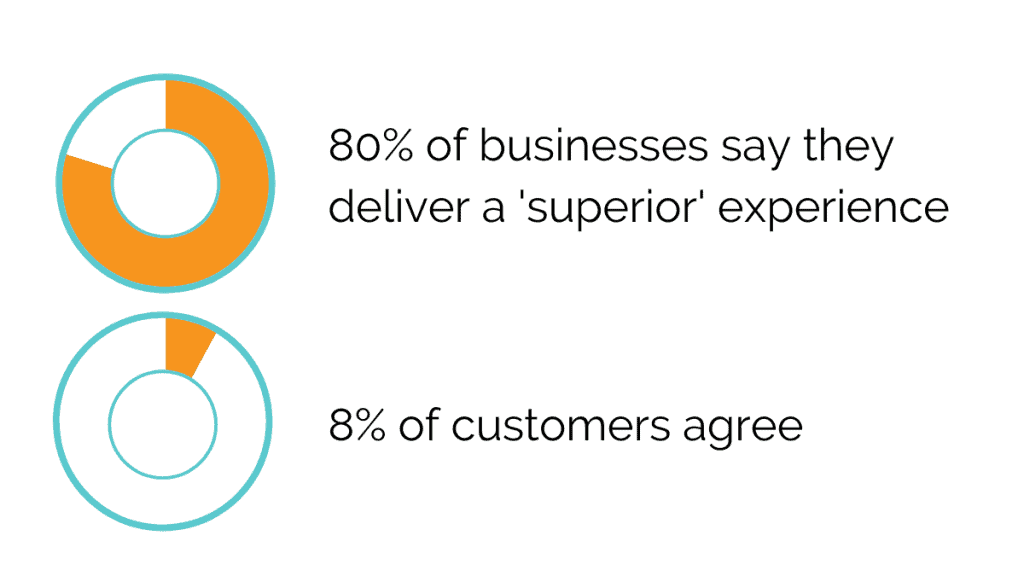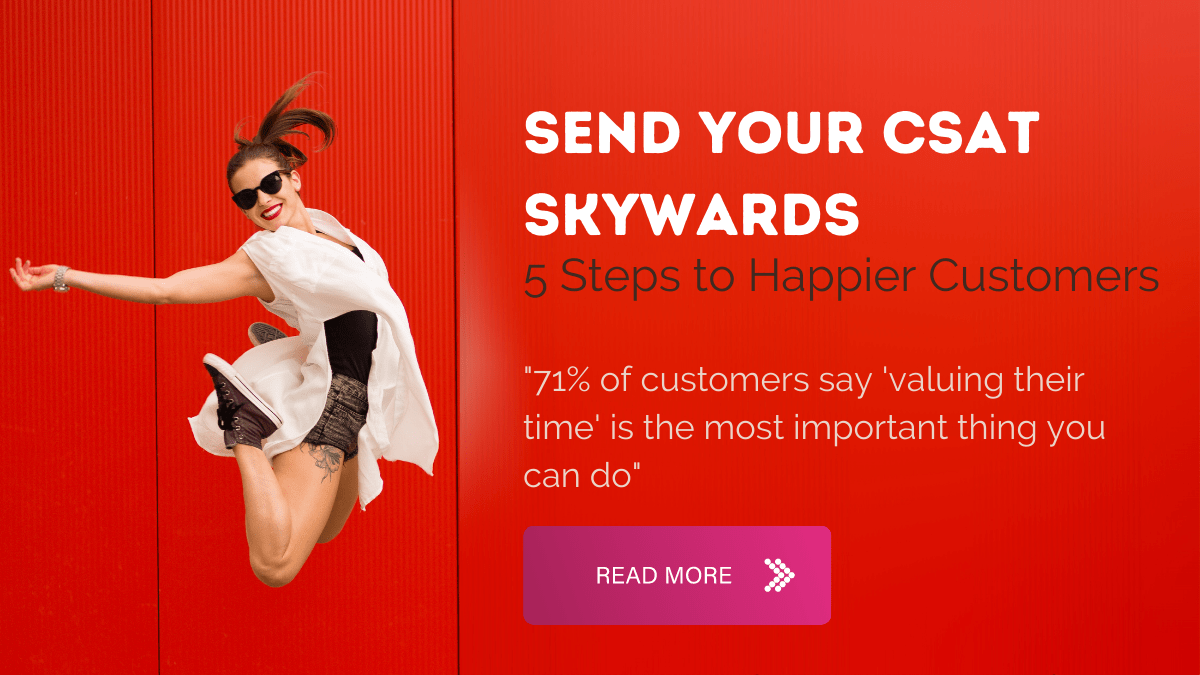Do you want to keep your customers? Then keep your customers happy.
You know how important experience is because you’re a customer.
And even if you’re an incredibly price-conscious customer, you know that saving a buck isn’t worth dealing with bad service.
Here’s the flipside – when a business can provide A+ experience to customers, they don’t need to lean on their pricing to keep up customer loyalty.
Their customer experience does all the heavy lifting.
So let’s talk about CSat.
In this post:
- Get more serious about self-service
- Target delays – make speed a priority!
- Personalize your services
- Automate agent guidance
- Respond to negative feedback
Get (more) serious about self-service
Customers will use decent self-service tools.
I know you’ve heard it before – ‘we have great self-service’ is the mating cry of the modern CX pro – but it’s worth saying again.
Why?
Because it’s such a huge win-win.
Customers want it and it saves you money. It’s like running a cocktail bar where customers demand more ice in their drinks, and less vodka.

Here are ready-made self-service wins:
Conversational AI is CSat gold
This is one of the most useful self-service tools around – conversational AI.
A lot of businesses are adding conversational capability to their existing IVR.
It’s quick to do and has one of the best ROIs of any tool. Most importantly, it has a very visible impact on CSat.
(For example – Amtrak used Conversational AI to lift CSat by 53%!)
SMS is still going strong
SMS is a veteran piece of tech now. In the last 20+ years it’s gained a lot of trust from the general public.
That’s probably why SMS is the first choice for messaging services over Facebook Messenger, Snapchat and WhatsApp.
It’s more important than ever to ‘go where the customers are’. Service channels are multiplying, but everyone has SMS.

Integration is *everything*
Ultimately, it’s not about the tools you use – it’s about the service you offer. This falls apart when customers, switching between channels, have to start from scratch.
Want to avoid that situation?
Then you need to connect your various systems and channels to create a consistent experience.
That means API integration, the absolute most robust integration method.
Once you get this part right, the rest falls into place!
Target delays! Great speed = great CSat
C ustomers want speedy service. It’s one thing we all agree on.
71% of customers say that ‘valuing their time’ is the most important thing a business can do.
So how do you speed things up?
Start with virtual queuing
Simple concept – never leave a customer in a queue.
Scenario: they need to speak with an agent but nobody is available.
Solution: invite them to hang up. (And then call them back – that bit is important!)
Virtual queuing means the customer won’t wait a second longer than if they’d stayed on the line. They just don’t have to listen to hold music. They can do… whatever they like.
The vast majority of customers get ‘extremely frustrated’ waiting on hold. That’s the exact opposite of being satisfied.
Do more with automated outbound calling
There’s a ton of opportunity to preempt customer contact. As much as 40% of call volume is unnecessary or avoidable!
That costs you money. What’s more, it’s terrible for CSat (because however great you are, customers don’t want to contact you. Sorry.)
You know the problems customers face. And you know how to solve them. So what’s stopping you reaching out to them with a little pre-emptive service?
Personalize your services
We spoke about speed already. Speed matters.
But… when polled, customers rated ‘being treated like an individual’ above ’speed of resolution’.
What does that really mean? It means you have to address the specific needs of specific customers. You have a ton of data about them – personalized service is probably way easier than you think.
Here are a few simple tips:
Recognize your customers
If I call someone I know, they know it’s me calling. It says my name on the screen of their phone. Even my 87 year-old grandmother is up to date with that tech.
So why don’t more businesses manage this? Why do you – yes, you – make me jump through hoops to identify myself?
This is easy – it makes customers feel welcome – it helps you serve the customer.
It’s a no-brainer.
Route your customers
If your routing methodology stops at service / sales / tech support, it’s not fit for purpose.
There’s a huge amount of data that you can bring into contact routing. Their preferences are right there in your call center CRM.
Their service tickets are right there in your Helpdesk software.
You know their recent purchases, their customer lifetime value and their latest NPS scores.
Act accordingly.
Automate agent guidance
Over three-quarters of customers get different answers from different agents.
What does that tell you? It tells me that the agents always don’t know the best way to solve customers’ problems.
It’s hard to think of a bigger CSat killer than that!
Agent training is part of the solution, sure. But… most contact centers have a pretty lousy retention rate for frontline staff.
That’s why contact centers are shifting to smart tools that use Natural Language Processing to guide agents.
These systems basically listen out for key words and phrases, and suggest next actions.
That kind of automated agent guidance is a big step beyond call scripting, right?
Apart from making service most consistent, it also speeds it up. In a six-minute service call, only 90 seconds is real interaction! The rest of the time is awkward silences during manual research.
Respond to negative feedback
It’s a tough concept to accept but… negative feedback is great.
There are no perfect businesses; every one of them could improve. To do that, they need input from customers.
Put it this way: Usain Bolt didn’t get to be the world’s fastest man on a 100% positivity. people told him how to improve. (And he listened.)
Here are the steps to becoming the Usain Bolt of customer feedback:
#1 Ask for feedback
It can be user panels, online forms, social media or anything else. Doesn’t matter. Consumers strongly prefer brands that ask for feedback, so ask for feedback!
Focus on:
- Your product
- Your customer service
- Your business’s performance over time
#2 Categorize that feedback
There are a ton of ways to do this; customer type, feedback type, interaction type… you get the idea.
Just don’t throw a lot of disparate pieces of feedback into the blender and expect to make sense of it!
#3 Act on the feedback
This is where most businesses fail. But let’s be straight – there is zero point collecting feedback that you don’t use.
Two-thirds of businesses now have a CX leader and a centralized CX team. This stuff is their whole raison d’etre.
#4 Follow up on feedback
In terms of boosting CSat, this is the most important step. Half of customers don’t believe that their feedback goes to anyone who can act on it.
That gives you a huge opportunity to be exceptional in their eyes!
Say it with me now: ‘Thanks for your feedback! Here’s what we’re doing based on your comments…’
At the top of this post we talked about Conversational AI. This tech is doing a lot of hard work in CX right now; it’s a data collecting, customer-facing, cost-cutting machine… literally.





